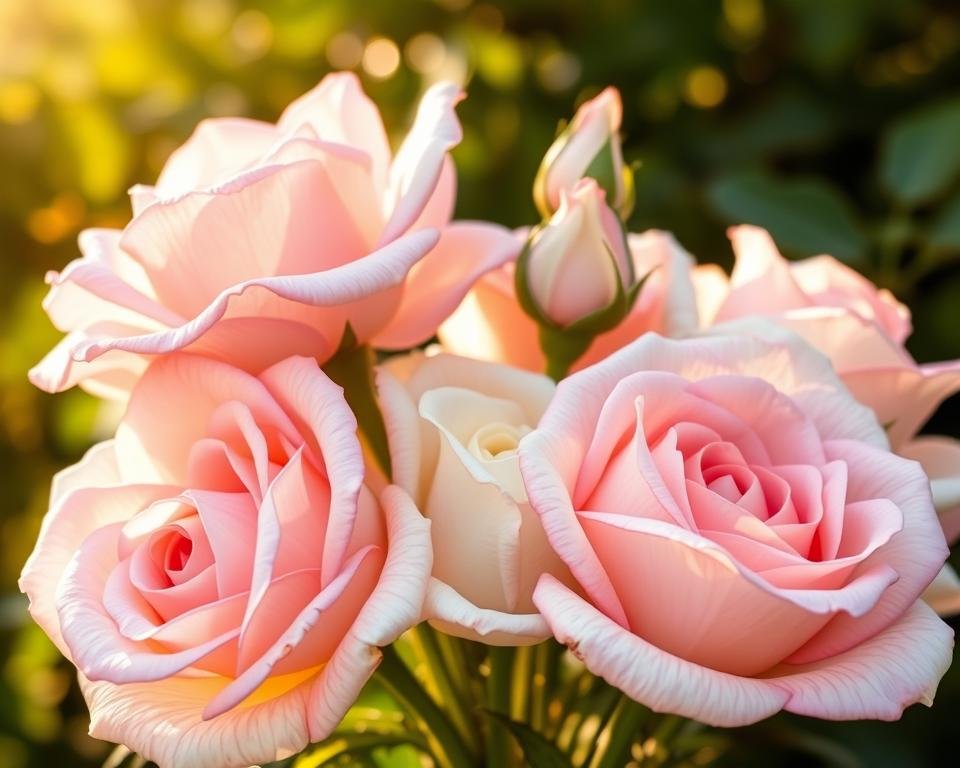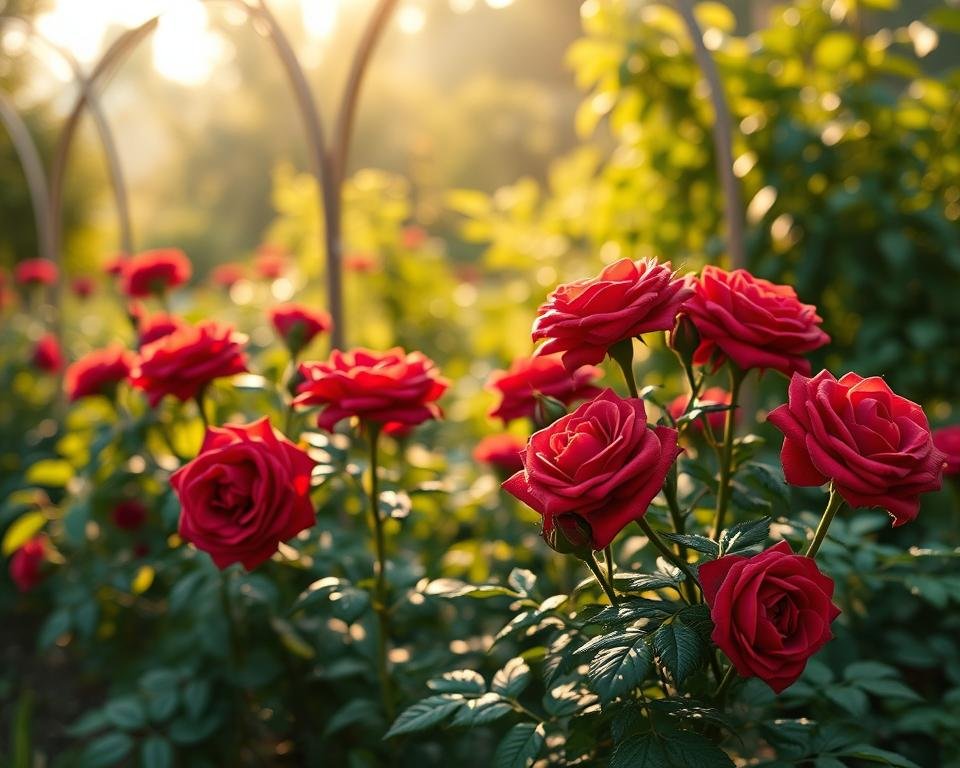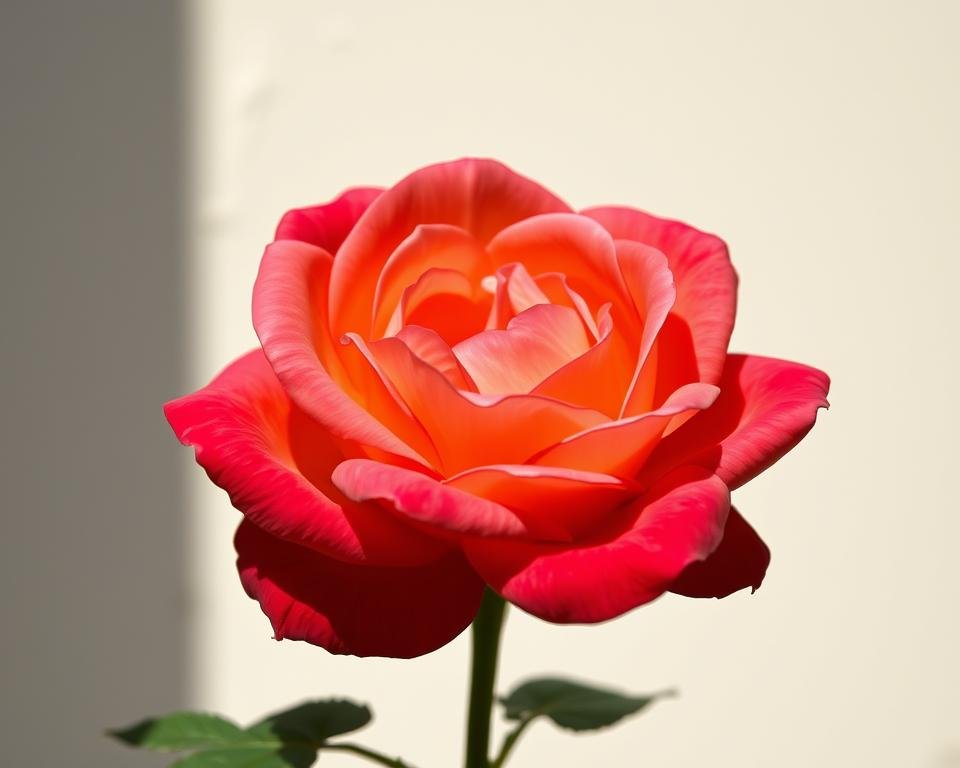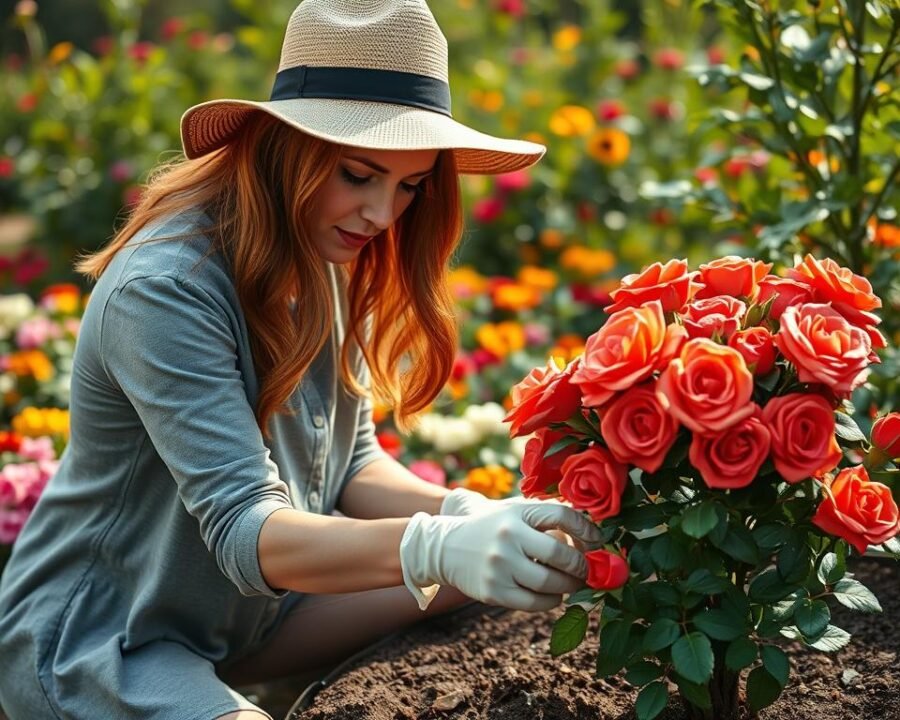The Eugenie garden rose is a symbol of elegance and grace. Its soft, blush peach and apricot colors are truly captivating. As it blooms, it turns into a stunning rosette, showing off its beauty and class.
The Eugenie rose is loved by many for its beauty. It stands out in any flower arrangement. It’s perfect for adding elegance to your garden or making a beautiful bouquet.
Key Takeaways
- The Eugenie garden rose is known for its delicate, blush peach and apricot hues.
- It blossoms into a flamboyant rosette, exuding a sense of elegance and refinement.
- This rose is a favorite among rose enthusiasts due to its captivating beauty.
- The Eugenie rose is perfect for adding a touch of elegance to your garden or creating a stunning bouquet.
- Its unique beauty makes it a standout in any floral arrangement.
The Enchanting World of Roses
As we enter the world of roses, we find a place of stunning beauty and sweet scent. Roses have amazed gardeners and flower lovers for ages. Their charm still inspires and pleases us today.
David Austin Roses are the stars of the cut flower world. They offer breathtaking blooms and a scent that fills the air. Roses are a key part of our gardens and lives.
The Significance of Roses in Gardens
Roses bring elegance and class to any garden. They come in many colors, shapes, and sizes. This variety makes them a favorite for garden design. For more on David Austin Eugenie’s stunning blooms, visit our article.
- Roses create a romantic and fragrant atmosphere outdoors.
- They draw in bees and butterflies, helping our gardens thrive.
- Roses can be the main attraction or add a special touch in gardens.
What Makes Garden Roses Special
Eugenie roses are famous for their beautiful blooms and strong scent. This makes them a favorite among rose fans.
Some key features of garden roses include:
- Fragrance: Many garden roses have a strong scent that fills the air.
- Bloom shape: Roses come in different shapes, from classic to modern designs.
- Disease resistance: Modern garden roses are often bred to be disease-resistant, making them easier to care for.
Understanding the Eugenie Garden Rose
The Eugenie garden rose is a prized variety in David Austin’s Wedding Rose Collection. It’s loved by many rose fans. This rose stands out because of its rich history and unique traits.
History and Origin
The Eugenie rose is part of David Austin’s famous collection. It’s known for its romantic and nostalgic charm. David Austin’s breeding program has made roses that are beautiful, fragrant, and strong. The Eugenie rose, with its soft, blush-colored petals, shows this expertise.
Distinctive Characteristics
The Eugenie garden rose has romantic, ruffled petals and a classic look. It grows well and blooms a lot, making it a favorite among gardeners. It’s also great for different garden styles.

Fragrance Profile
The Eugenie rose has a delicate, sweet fragrance that lasts all day. This scent is a big reason why people love the Eugenie rose. It’s often used in perfumes and flower arrangements.
Some key features of the Eugenie rose include its:
- Romantic, ruffled petals in a blush hue
- Vigorous growth and abundant flowering
- Delicate, sweet fragrance
Popular Varieties of Eugenie Roses
Eugenie roses have won the hearts of many with their beauty and variety. They are loved for their looks and used in many flower arrangements. This makes them a favorite among rose fans.
There are many Eugenie rose types, divided into classic and modern. Each has its own special qualities.
Classic Eugenie Rose Varieties
Classic Eugenie roses are cherished for their timeless charm and scent. They have been a part of gardens and flower arrangements for ages. They bring a sense of tradition and heritage. Some well-known classic types are:
- Old Garden Roses, known for their strong scent and old-world charm.
- Hybrid Perpetual Roses, which bloom often and grow strong.
Modern Cultivars and Hybrids
Modern Eugenie rose types bring a new twist to the classic rose. They have better disease resistance, bright colors, and unique smells. Some standout modern varieties are:
- English Roses, blending old-world scent and look with modern disease resistance.
- Hybrid Tea and Floribunda Roses, offering a wide range of colors and growth patterns. They are great for many garden and flower designs.
These modern types keep growing, giving gardeners and florists more Eugenie rose varieties to explore.
Selecting the Perfect Location for Your Eugenie Roses
Eugenie roses are a lovely addition to any garden. But, they need the right spot to grow well. Choose a location that fits their needs for the best results.
Sunlight Requirements
Eugenie roses love lots of sunlight to bloom well. They need at least 6 hours of direct sunlight each day. Adequate sunlight helps them grow and flower healthily.

Soil Conditions and Preparation
The soil should drain well and be rich in organic matter. To get your soil ready, add compost or well-rotted manure. This will make the soil better for your roses, giving them a nourishing environment.
| Soil Type | Characteristics | Preparation Tips |
|---|---|---|
| Clay Soil | Heavy, prone to waterlogging | Add organic matter to improve drainage |
| Sandy Soil | Dry, lacks nutrients | Add compost to retain moisture and nutrients |
| Loamy Soil | Balanced, fertile | Ideal for Eugenie roses, minimal preparation needed |
Spacing Considerations
Spacing is key to avoid overcrowding and ensure air flow. Eugenie roses should be 2-3 feet apart, depending on the type. This keeps them healthy and encourages more blooms.
Step-by-Step Guide to Planting Eugenie Garden Roses
To add Eugenie garden roses to your garden, follow our easy guide. Planting these roses needs some prep and care. But with the right steps, you’ll enjoy their stunning blooms for years.
Best Time for Planting
The best time to plant Eugenie garden roses varies by location. Spring and fall are usually the best times. In mild winters, plant in fall. In colder areas, wait until spring. This lets the rose grow before summer heat or winter cold.
Preparing Bare Root Roses
Garden roses are often shipped in cardboard. When you unwrap them, check the roots for damage. Trim any bad roots with sharp shears. Then, soak the roots in water for a few hours. This helps them grow strong and healthy.
Planting Container Roses
When planting container roses, remove them carefully to avoid root damage. If the roots are circling, gently loosen them. Dig a hole that’s a bit bigger than the root ball. Plant the rose at the same depth as it was in the container.
Post-Planting Care
Water your Eugenie garden rose well after planting. Make sure the soil is moist but not too wet. Add mulch around the base to keep moisture in and weeds out. Keep the area clean and provide regular care like watering, fertilizing, and pruning. This will help your rose grow strong and bloom beautifully.
Essential Watering Techniques for Healthy Eugenie Roses
To keep Eugenie roses healthy, learning how to water them is key. Eugenie roses, like many other types, need the right amount of water to grow well. Good watering helps them grow strong and look beautiful.

Watering Frequency and Timing
How often and when to water Eugenie roses depends on a few things. These include the weather, soil, and how old the plant is. Roses usually need about 1-2 inches of water each week, from rain or a hose.
It’s better to water deeply once or twice a week, not every day. Avoid watering during the hottest part of the day to save water and help it soak into the soil.
Watering Methods and Tools
There are many ways to water Eugenie roses, like soaker hoses, drip irrigation, and watering cans. Soaker hoses and drip systems send water straight to the roots, saving water and preventing runoff. Watering cans let you get close to the plants and check on them while you water.
No matter the tool, water at the base of the plant. This keeps the leaves dry and prevents diseases.
Signs of Improper Watering
Too much or too little water can harm Eugenie roses. Too much water can cause yellow leaves, droopy stems, and rotting roots. Not enough water makes leaves wilt, slows growth, and makes plants more vulnerable to pests.
Watching your Eugenie roses closely helps you catch these problems early. This way, you can change your watering schedule as needed. Remember,
“A rose’s health is reflected in its leaves and blooms.”
Pay attention to these signs to make sure your Eugenie roses are getting the right amount of water.
Mastering Eugenie Rose Pruning Techniques
For a stunning Eugenie rose garden, proper pruning is key. Pruning is more than cutting stems; it’s an art. It promotes healthy growth, encourages blooming, and keeps the garden looking great.
Essential Pruning Tools
To prune Eugenie roses well, you need the right tools. You’ll need sharp, clean pruning shears, long-handled loppers for thick branches, and gloves to protect your hands. Good tools make pruning easier and safer.
Seasonal Pruning Timeline
Prune Eugenie roses in late winter or early spring. This is before new growth starts. It helps avoid disease and promotes strong growth later. Some also prune lightly after the first bloom for more flowers.
Step-by-Step Pruning Guide
Pruning Eugenie roses involves several steps:
Removing Dead and Diseased Wood
Begin by removing dead, diseased, or damaged branches. This stops disease spread and encourages healthy growth.
Shaping and Thinning
Then, shape the rose bush by cutting back overgrown branches. Thin the center for better air circulation. This is key for the plant’s health and look.
Pruning Safety Tips
When pruning Eugenie roses, safety is crucial. Wear gloves and eyewear, and watch your surroundings to avoid accidents. Make clean cuts at a 45-degree angle, and don’t tear the bark.
Mastering these pruning techniques will help you keep your Eugenie rose garden beautiful and thriving. Regular pruning not only makes your roses look better but also keeps them healthy and strong.
Fertilizing Your Eugenie Garden Rose for Spectacular Blooms
To get amazing blooms from your Eugenie garden rose, you need a good fertilizing plan. Fertilizing is key for rose care. It gives the nutrients needed for growth and beautiful flowers.

Types of Rose Fertilizers
There are many fertilizers for Eugenie garden roses. You can choose from balanced, organic, or rose-specific fertilizers. Balanced fertilizers have equal amounts of nitrogen, phosphorus, and potassium. They help the plant stay healthy. Organic fertilizers, like compost, give nutrients slowly and make the soil better over time.
Seasonal Fertilizing Schedule
It’s important to fertilize your Eugenie garden rose at the right times. Fertilize in early spring, after the first bloom, and in late summer. This helps with growth, blooming, and getting ready for the next season.
- Early spring: Apply a balanced fertilizer to promote new growth.
- After the first bloom: Use a fertilizer high in phosphorus to encourage blooming.
- Late summer: Apply a balanced fertilizer to prepare the plant for the next season.
Application Techniques
How you apply fertilizer is just as important. Always follow the instructions on the fertilizer package. Avoid over-fertilizing to prevent root damage. A slow-release fertilizer gives nutrients all season long.
Knowing about different fertilizers, following a fertilizing schedule, and applying correctly helps your Eugenie garden rose grow well. This leads to stunning blooms.
Seasonal Care Guide for Eugenie Roses
To keep your Eugenie roses healthy and vibrant, a seasonal care routine is essential. As the seasons change, so do the needs of your roses. By following a simple yet effective care guide, you can ensure your Eugenie roses thrive throughout the year.
Spring Care Routine
In the spring, Eugenie roses begin a new growth cycle. Start by removing any dead or damaged branches from the previous season. Apply a balanced fertilizer to promote healthy growth, and mulch around the base to retain moisture and suppress weeds. Inspect your roses regularly for signs of pests or diseases, and take action promptly if necessary. This care routine sets the stage for a vibrant blooming season.
Summer Maintenance Tips
During the summer, Eugenie roses are in full bloom. Ensure they receive adequate water, especially during hot and dry spells. Deadheading spent blooms encourages continued flowering. Keep an eye out for signs of stress, such as yellowing leaves or black spot, and address these issues promptly. Summer is also a good time to inspect your roses for signs of pests like aphids or spider mites.
Fall Preparation Steps
As fall approaches, Eugenie roses begin to slow their growth. Reduce watering and stop fertilizing to allow the roses to harden off for the winter. Remove any remaining foliage that may be diseased or damaged. This is also a good time to inspect your rose bushes for any signs of disease or pest infestations, and take action if necessary. By preparing your roses for the winter, you ensure their health and vitality for the next growing season.
Winter Protection Methods
In the winter, Eugenie roses require protection from harsh weather conditions. Apply a thick layer of mulch or straw around the base to insulate the roots. In colder climates, consider providing additional protection, such as burlap or rose cones, to shield the plants from wind and extreme cold. By taking these simple steps, you can help your Eugenie roses survive the winter and emerge healthy and strong in the spring.
| Season | Care Tips |
|---|---|
| Spring | Remove dead branches, fertilize, and mulch |
| Summer | Adequate watering, deadheading, and pest control |
| Fall | Reduce watering, stop fertilizing, and remove diseased foliage |
| Winter | Apply mulch, and provide additional protection in cold climates |
Troubleshooting Common Eugenie Rose Problems
Growing Eugenie roses comes with its own set of challenges. These beautiful flowers can face pests and diseases that harm their health and beauty. It’s important to be ready to tackle these issues.
Identifying and Treating Pests
Eugenie roses can get attacked by pests like aphids, Japanese beetles, spider mites, and thrips. Spotting these pests early is key to treating them effectively.
Aphids and Japanese Beetles
Aphids are small, soft insects that can curl leaves. Japanese beetles, with their shiny blue and copper color, can damage leaves. To fight aphids, use insecticidal soap or neem oil. For Japanese beetles, hand-picking or pyrethrin-based insecticides work well.
Spider Mites and Thrips
Spider mites turn leaves yellow or bronze, while thrips distort flowers and leaves. To control spider mites, use miticides or insecticidal soap. For thrips, try insecticidal soap or systemic insecticides.
Preventing and Managing Diseases
Eugenie roses can also get sick with diseases like black spot, powdery mildew, rust, and rose rosette disease. Knowing about these diseases and how to prevent them is crucial for healthy roses.
Black Spot and Powdery Mildew
Black spot shows as black spots on leaves, while powdery mildew looks like a white, powdery film. To stop black spot, improve air flow and remove sick leaves. For powdery mildew, use fungicides or sulfur-based products.
Rust and Rose Rosette Disease
Rust shows as orange or yellow spores on leaves, while rose rosette disease causes distorted growth. To fight rust, remove sick leaves and use fungicides. Rose rosette disease is harder to control and might need the plant to be removed.
Organic Prevention Methods
There are organic ways to prevent pests and diseases. Using compost tea, keeping the garden clean, and attracting beneficial insects are good methods. These approaches help avoid chemical pesticides and fungicides, making the garden healthier for Eugenie roses.
Propagating and Expanding Your Eugenie Rose Collection
Rose lovers enjoy growing Eugenie roses. It’s a fun way to share and grow their favorite varieties. By using the right techniques, we can multiply these beautiful flowers and enjoy more of their stunning blooms.
Propagating Eugenie roses not only expands our collection. It also lets us share the beauty of these roses with friends and family.
Propagation by Cuttings
One common way to propagate Eugenie roses is through cuttings. This involves taking a section of a stem from a mature rose bush and encouraging it to grow roots. To increase the chances of success, we should take cuttings from healthy, vigorous stems.
The best time to take cuttings is in late spring or early summer. This is when the stems are semi-soft. We should remove lower leaves, dip the cut end in rooting hormone, and plant it in a well-draining potting mix.
Grafting Techniques for Roses
Grafting is another effective method for propagating Eugenie roses. This involves joining a piece of stem (called a scion) from one rose bush to the root system of another (called a rootstock). Grafting allows us to combine the desirable qualities of different rose varieties.
To graft Eugenie roses, we need to make a small incision in the rootstock and insert the scion. We secure it with tape or wax. With proper care, the grafted rose will grow and thrive, producing beautiful blooms.
Conclusion: Enjoying the Timeless Beauty of Eugenie Roses
Our journey through the Eugenie garden rose has shown us its beauty and charm. It’s like a memory from grandma’s garden. It’s perfect for a bride who wants to remember her childhood.
Eugenie roses can brighten up any space, from our gardens to special events. Their beauty and scent are timeless. We can enjoy them in many ways.
Knowing about Eugenie roses’ history, traits, and care helps us appreciate them more. They bring joy and elegance to our lives. Let’s keep enjoying Eugenie roses and the beauty they add to our world.
FAQ
What is the ideal sunlight requirement for Eugenie garden roses?
Eugenie garden roses need at least 6 hours of direct sunlight daily. They do best in full sun to partial shade.
How often should I water my Eugenie roses?
Watering Eugenie roses depends on the weather. Generally, we water them deeply once or twice a week. The soil should be moist but not too wet.
What type of fertilizer is best for Eugenie garden roses?
Use a balanced, slow-release fertilizer made for roses. It gives them the nutrients they need for growth and blooms.
How do I prune my Eugenie roses?
Pruning Eugenie roses means cutting off dead, diseased, or damaged branches. It also shapes the plant for better growth and blooms. Prune in late winter or early spring with sharp tools.
Can I propagate Eugenie roses by cuttings?
Yes, Eugenie roses can be grown from cuttings. Take healthy stems, root them in a well-draining mix, and keep the soil moist until roots grow.
What are some common pests and diseases that affect Eugenie roses?
Eugenie roses face pests like aphids, whiteflies, and spider mites. They also get diseases like black spot, powdery mildew, and rust. Watch your plants closely and act fast if problems arise.
How do I protect my Eugenie roses from winter damage?
To shield Eugenie roses from winter harm, mulch or straw around the base helps. Also, cover them with burlap or a frost blanket if it gets cold.
What are some popular varieties of Eugenie roses?
Eugenie roses come in many varieties, from classic to modern. We have a selection known for their beauty, scent, and resistance to disease.
